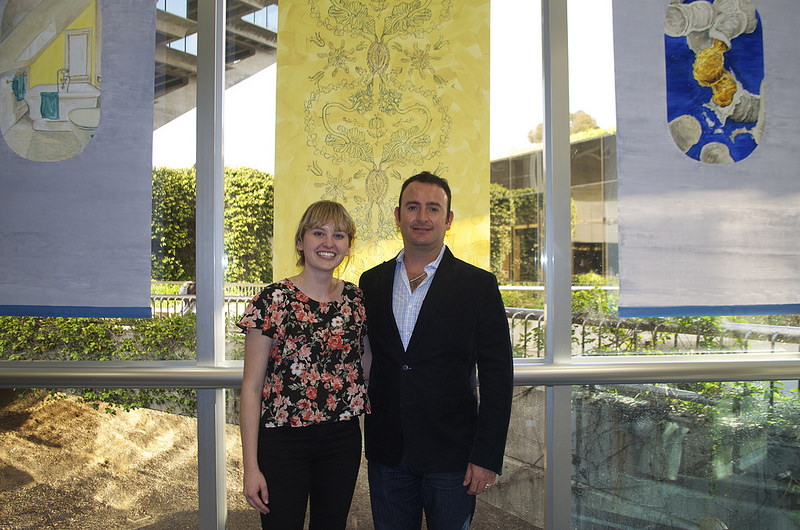Posted On: May 27, 2015
UCSD student’s art show inspired by collaboration with the Jaffe Lab at Scripps
Original Article Written By: Brittany Hook, Scripps Institution of Oceanography
Artistic depictions of zooplankton currently adorn the walls of UC San Diego’s Geisel Library, as well as the entrance of the Biomedical Library, thanks to a showcase created by UC San Diego biology student and artist Elizabeth Stringer.
Stringer’s two-part exhibit, My Meditations End in Reverie, was inspired by the time she has spent working as a volunteer in the Jaffe Laboratory for Underwater Imagery and in the Physical-Biological Interactions Lab of biological oceanographer Peter Franks at Scripps Institution of Oceanography, a part of UC San Diego. The exhibit’s paintings and backlit photographs bring to life the mysterious world of zooplankton, microscopic animals that float near the surface in marine environments.
This project has allowed Stringer, a double major in human biology and studio arts, to combine her passion for science with the arts. “I use my art practice to express my own passion that I have for biology and to play and make sense of the biological facts swimming in my head,” said Stringer.
Part of her current installation features a series of long canvases displaying intricate patterns and artistic renderings of pathological and taxonomic systems. Stringer describes these paintings as a poetic exploration of the microcosm, a small-scale representation of the immense scientific and biological database in her mind.
“By studying this, I am able to manipulate the massive amount of biological visual information that influxes through me that I use to create a miniature personal world,” she explained.
The second part of her installation features images of zooplankton backlit by various colors, mounted behind acrylic Plexiglas within small wooden boxes.
This project was directly inspired by Stringer’s work in the Jaffe Lab, where for the past year she has helped Scripps PhD student Christian Briseno sort and categorize zooplankton using images taken from the O-Cam, a special microscopic lens developed at Scripps Oceanography. The O-Cam lens is part of the Jaffe Lab’s larger FIDO-Phi-Pi project, an underwater, three-dimensional stereo particle imagery system that allows in situ photography.
In order to view and categorize the zooplankton, Stringer zoomed in and out on the O-Cam’s toggle and then screen captured images of “chance movements that captured when zooplankton and other matter became aesthetic foreign entities.” Stringer describes this fleeting moment as if arriving from the depths of her unconscious, with zooplankton “quickly appearing, then disappearing, when they became a data point within a categorized counting system.”
While working closely with Briseno, Stringer listened to him recount different facts about each zooplankton as they were presented on the screen. During this process, she realized that each researcher has developed an intimate relationship with his or her microscopic niche of study. Stringer’s work seeks to highlight what she describes as the “inspirational moment” when a researcher or viewer confronts an aesthetically beautiful image while also categorizing intimate information on the creature itself.
“With this series, I wanted to give the viewer a glimpse of that rich internal, cerebral environment while, at the same time, harnessing the images to construct a psychological profile of the researcher,” said Stringer. “Also, I wanted to draw attention to the specific field of zooplankton and exalt this area of study as both bountiful information and sublime mystery worthy of exploration.”
Stringer’s lab-mates and mentors appreciate the unique point of view that she conveys through her science-based artwork.
“Surely, Elizabeth’s work and the perspective that she shares stimulates us to think about our images in a different way,” said Scripps research oceanographer Jules Jaffe. “I think that she takes the aesthetic experience to the next level and in a different direction from a perspective that is non-technical but still highlights the beauty of the natural world.”
The Jaffe Lab is renowned for its development of new technology for observing oceanic phenomena. Some of the lab’s recent developments include the Scripps Plankton Camera, which was deployed at the end of the Scripps Pier in March, and the Scripps Phytoplankton Camera, which was deployed last September. Both cameras provide stunning images of plankton on a daily basis.
Stringer unveiled her artwork during an Earth Day event sponsored by the UC San Diego Library. The event, titled “Using 3D Imaging to Shed Light on the Unseen Beauty Beneath the Sea,” included presentations by key speakers Jaffe, Franks, and Briseno on the use of optical tools to study the mysterious underwater world of plankton.
At the event, Stringer described Briseno, Jaffe, and Franks as “inspirational” and noted that she looks forward to continuing her volunteer work in the Jaffe Lab and in Frank’s Physical-Biological Interactions Lab. Post-graduation from UC San Diego next year, Stringer hopes to continue the practice of combining research with art.
“I now know that both science and art have always been intertwined and they are also eternally intertwined within me,” she said.
My Meditations End in Reverie will remain on display in the Seuss Room Foyer at Geisel Library and in the entry to the Biomedical Library at UC San Diego through May.

